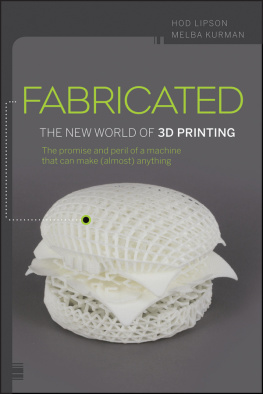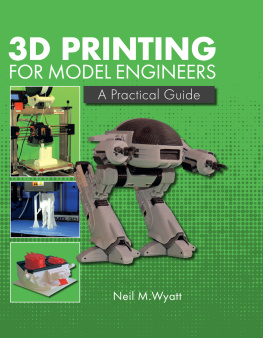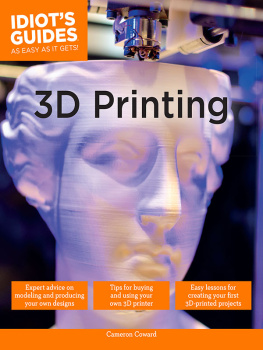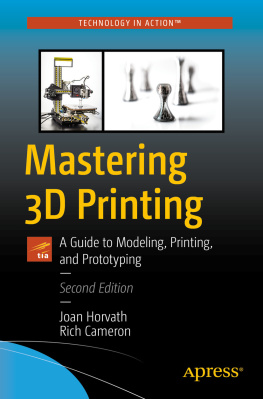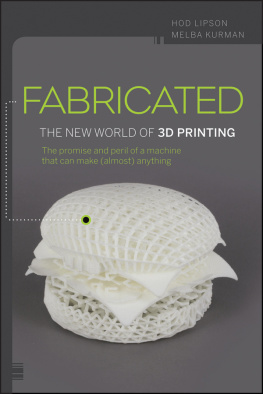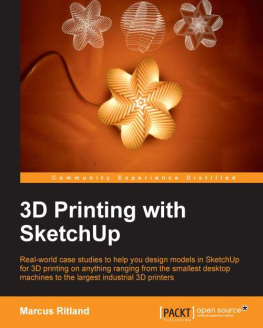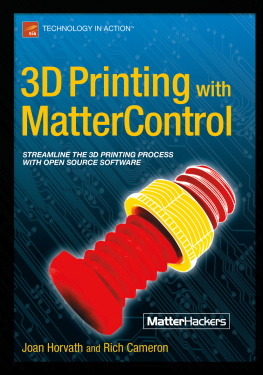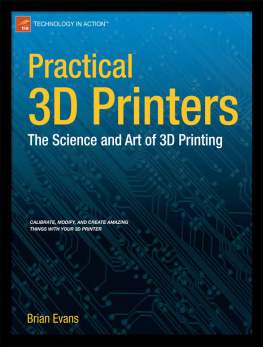Fabricated: The New World of 3D Printing
Published by
John Wiley & Sons, Inc.
10475 Crosspoint Boulevard
Indianapolis, IN 46256
www.wiley.com
Copyright 2013 by John Wiley & Sons, Inc., Indianapolis, Indiana
Published simultaneously in Canada
ISBN: 978-1-118-35063-8
ISBN: 978-1-118-41024-0 (ebk)
ISBN: 978-1-118-41694-5 (ebk)
ISBN: 978-1-118-63551-3 (ebk)
Manufactured in the United States of America
10 9 8 7 6 5 4 3 2 1
No part of this publication may be reproduced, stored in a retrieval system or transmitted in any form or by any means, electronic, mechanical, photocopying, recording, scanning or otherwise, except as permitted under Sections 107 or 108 of the 1976 United States Copyright Act, without either the prior written permission of the Publisher, or authorization through payment of the appropriate per-copy fee to the Copyright Clearance Center, 222 Rosewood Drive, Danvers, MA 01923, (978) 750-8400, fax (978) 646-8600. Requests to the Publisher for permission should be addressed to the Permissions Department, John Wiley & Sons, Inc., 111 River Street, Hoboken, NJ 07030, (201) 748-6011, fax (201) 748-6008, or online at http://www.wiley.com/go/permissions .
Limit of Liability/Disclaimer of Warranty: The publisher and the author make no representations or warranties with respect to the accuracy or completeness of the contents of this work and specifically disclaim all warranties, including without limitation warranties of fitness for a particular purpose. No warranty may be created or extended by sales or promotional materials. The advice and strategies contained herein may not be suitable for every situation. This work is sold with the understanding that the publisher is not engaged in rendering legal, accounting, or other professional services. If professional assistance is required, the services of a competent professional person should be sought. Neither the publisher nor the author shall be liable for damages arising herefrom. The fact that an organization or Web site is referred to in this work as a citation and/or a potential source of further information does not mean that the author or the publisher endorses the information the organization or website may provide or recommendations it may make. Further, readers should be aware that Internet websites listed in this work may have changed or disappeared between when this work was written and when it is read.
For general information on our other products and services please contact our Customer Care Department within the United States at (877) 762-2974, outside the United States at (317) 572-3993 or fax (317) 572-4002.
Wiley publishes in a variety of print and electronic formats and by print-on-demand. Some material included with standard print versions of this book may not be included in e-books or in print-on-demand. If this book refers to media such as a CD or DVD that is not included in the version you purchased, you may download this material at http://booksupport.wiley.com . For more information about Wiley products, visit www.wiley.com .
Library of Congress Control Number: 2012954401
Trademarks: Wiley and the Wiley logo are trademarks or registered trademarks of John Wiley & Sons, Inc. and/or its affiliates, in the United States and other countries, and may not be used without written permission. All other trademarks are the property of their respective owners. John Wiley & Sons, Inc. is not associated with any product or vendor mentioned in this book.
To Tiina and Jri Kurman
To Rina and Stephen Lipson
About the Authors
Hod Lipson is a professor of engineering at Cornell University in Ithaca, New York. His work on automatic design and manufacture of robotic life forms, self-replicating robots, food printing, and bioprinting has received widespread media coverage including The New York Times , The Wall Street Journal , Newsweek , Time , and NPR. Lipson has co-authored hundreds of papers and speaks frequently at high-profile venues such as TED and the National Academies. Hod directs the Creative Machines Lab, which pioneers new ways to make machines that create, and machines that are creative. Visit http://www.mae.cornell.edu/lipson .
Melba Kurman is a technology writer, analyst, and popular blogger. She became interested in additive manufacturing and emerging design software two years ago when she noticed that the same manufacturing machine could print custom dental crowns, coffee tables, and heavy-duty, end-use metal machine parts. Her passion is explaining the value of complex technologies in everyday language. In the past she helped Cornell University, Microsoft, and other organizations bring new technologies to market. Melba is a graduate of Cornell University, the University of Illinois, and the U.S. Peace Corps.
Credits
Acquisitions Editor
Mary James
Senior Project Editor
Kevin Kent
Technical Editor
Duane Storti
Production Editor
Kathleen Wisor
Copy Editor
San Dee Phillips
Editorial Manager
Mary Beth Wakefield
Freelancer Editorial Manager
Rosemarie Graham
Associate Director of Marketing
David Mayhew
Marketing Manager
Ashley Zurcher
Business Manager
Amy Knies
Production Manager
Tim Tate
Vice President and Executive Group Publisher
Richard Swadley
Vice President and Executive Publisher
Neil Edde
Associate Publisher
Jim Minatel
Project Coordinator, Cover
Katie Crocker
Compositor
Kate Kaminski, Happenstance Type-O-Rama
Proofreader
Josh Chase, Word One, New York
Indexer
Johnna VanHoose Dinse
Cover Designer
Ryan Sneed
Front Cover Product Design
netfabb GmbH
Front Cover Image
Paulo Kiefe, Creative Tools
Back Cover Images
Objet Inc. and Olaf Diegel
Acknowledgments
This book grew organically from illuminating and inspiring conversations with many people. Wed like to thank the following people for taking the time to speak with us and to review the books content.
Duane Storti for his technical expertise and all-around useful insights; Robert Schouwenburg for his passion for all facets of 3D printing: technology, design, and business strategy; Timothy Weber, for the elucidating discussions, good laughs and A-ha moments; Eric Haines for thoughtful feedback and valuable insights; Mark Ganter for endless creativity in pushing the limits of the technology; Cathy Lewis, Rajeev Kulkarni, and Abe Reichtental, for hosting us at 3D Systems and sharing their vision; Brandon Bowman for discussions on food printing; Gonzalo Martinez for shedding light on the future of CAD; Adam Mayer for showing us around MakerBot; Bill Young and Ted Hall for sharing their first-hand experience in personal manufacturing; John T. Lee for showing us the myriad finer points of the commercial 3D printing process; Adrian Bowyer for hosting us at the University of Bath and his insights into intellectual property, the future of additive manufacturing, and for leading the RepRap revolution; Philip Delamore, Anthony Ruto, Ross Barber, and Hoon Chung for hosting us at the London College of Fashion; Jeroen van Ameijde for hosting us at the Architectural Association School of Architecture, London; Glen Bull, Jennie Chiu, William Kjellstrom, and Jake Cohen from the University of Virginia for teaching us about teaching; Jonathan Butcher and Yaser Shanjani for speaking to us about bioprinting; Chris Johnson for elucidating the future of CAD; Dave White and Ryan Cain for sharing their experiences with 3D printing in the classroom; Jenny Sabin for showing us her work of bio-inspired architecture; Jesse Roitenberg for enlightening us about Stratasyss involvement in education; Josh Harker and Eyal Gever for talking to us about their pioneering 3D printed art; Eduardo Napadensky, Ofer Shochet, and Daniel Dikovsky for inviting us on many visits to Objet and sharing with us the future of digital materials; Terry Wohlers for great research and analysis and sharing his data; Chuck Hull, Joe Beaman, and Carl Deckard for founding the field; Joris Peels for introducing us to Shapeways and Materialise; Michael Guslick for challenging our presumption on what should be printed; Noy and Maor Schaal for daring to make some of the first printed food in history; Franz Nigl and Jeff Lipton for designing and creating elaborate multi-material cookies. And finally, to netfabb GmbH for designing the 3D printed hamburger on this book's cover, and to Paulo Kiefe of CreativeTools for freely sharing the image. The cover photo shows an art piece designed by netfabb using Selective Space Structures. The part takes advantage of the freedom in form and function offered by additive manufacturing. By mimicking the way nature uses structures the burger combines many different types of structures in one part to achieve different properties from a basic material. The piece was built using laser sintered PA by FIT Fruth Innovative Technologien GmbH in 2009.
Next page
